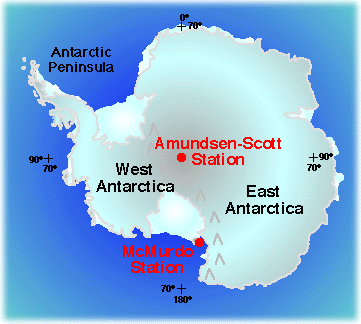
|


I will be working with The Antarctic Submillimeter Telescope / Remote Observatory (AST/RO) at Amundsen-Scott South Pole Station. AST/RO is a radio telescope that looks at the distribution of molecules in interstellar space to understand the composition of molecular clouds and how this leads to star formation and galactic structure. Since AST/RO is inaccessible most of the year, the summer months of November through February is the time when maintenance and upgrades to the telescope are possible. After this brief window, one person stays behind with the telescope to keep it running during the winter months. While at the pole in December 2000, I will be involved with the installation of a 4 channel 810 GHz receiver called PoleStar. As part of the installation process, we will be taking some data which will illustrate what a radio telescope can see. I am excited to be part of the AST/RO team, and have a chance to work with the telescope and share my experiences here. The south pole is a unique environment, and one of the ideal places on earth to have a radio telescope. Since the frequencies of light that the telescope looks at are absorbed by water molecules in the atmosphere, it is advantages to be at an altitude of more than 9,300 feet with cold temperatures, resulting in an extremely low level of water between the telescope and outer space. Radio astronomy is also very different than what most people associate with astronomy. Looking at objects with detectors other than your eyes allows you to see different aspects of the sky, as well as being able to observe while the sun is up. I am looking forward to immersing myself in radio astronomy, and sharing my experiences here. I encourage you to follow my adventures, and share your thoughts, questions and comments.
 
31 December, 2000: New Yearıs Eve Aligning the Telescope Food, Glorious Food! Environmental Control More coldhead maintenance Christmas Day Christmas Eve Coldhead Maintenance Solstice Skiing across Antarctica Cooling a Dewar Being sick Planes Christmas preparation Automated Geophysical Observatory (AGO) Raising a Telescope and Fire Drill The Weather Finishing little bits at AST/RO What we can see in the sky Weekend Life at the South Pole Fixing stuff Liquid Helium Fill The magic that makes AST/RO work. Introduction to AST/RO Launching an ozonesonde A brief introduction to radio astronomy Antarctic Research, Step 1: Getting There |


